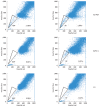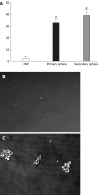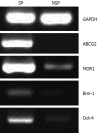Side population cells isolated from KATO III human gastric cancer cell line have cancer stem cell-like characteristics
- PMID: 22969237
- PMCID: PMC3435789
- DOI: 10.3748/wjg.v18.i33.4610
Side population cells isolated from KATO III human gastric cancer cell line have cancer stem cell-like characteristics
Abstract
Aim: To investigate whether the side population (SP) cells possess cancer stem cell-like characteristics in vitro and the role of SP cells in tumorigenic process in gastric cancer.
Methods: We analyzed the presence of SP cells in different human gastric carcinoma cell lines, and then isolated and identified the SP cells from the KATO III human gastric cancer cell line by flow cytometry. The clonogenic ability and self-renewal were evaluated by clone and sphere formation assays. The related genes were determined by reverse transcription polymerase chain reaction. To compare tumorigenic ability, SP and non-side population (NSP) cells from the KATO III human gastric cancer cell line were subcutaneously injected into nude mice.
Results: SP cells from the total population accounted for 0.57% in KATO III, 1.04% in Hs-746T, and 0.02% in AGS (CRL-1739). SP cells could grow clonally and have self-renewal capability in conditioned media. The expression of ABCG2, MDRI, Bmi-1 and Oct-4 was different between SP and NSP cells. However, there was no apparent difference between SP and NSP cells when they were injected into nude mice.
Conclusion: SP cells have some cancer stem cell-like characteristics in vitro and can be used for studying the tumorigenic process in gastric cancer.
Keywords: Cancer stem cells; Gastric cancer; KATO III; Self-renewal; Side population.
Figures




References
-
- Singh SK, Hawkins C, Clarke ID, Squire JA, Bayani J, Hide T, Henkelman RM, Cusimano MD, Dirks PB. Identification of human brain tumour initiating cells. Nature. 2004;432:396–401. - PubMed
-
- Collins AT, Berry PA, Hyde C, Stower MJ, Maitland NJ. Prospective identification of tumorigenic prostate cancer stem cells. Cancer Res. 2005;65:10946–10951. - PubMed
-
- Fang D, Nguyen TK, Leishear K, Finko R, Kulp AN, Hotz S, Van Belle PA, Xu X, Elder DE, Herlyn M. A tumorigenic subpopulation with stem cell properties in melanomas. Cancer Res. 2005;65:9328–9337. - PubMed
-
- Seigel GM, Campbell LM, Narayan M, Gonzalez-Fernandez F. Cancer stem cell characteristics in retinoblastoma. Mol Vis. 2005;11:729–737. - PubMed
Publication types
MeSH terms
Substances
LinkOut - more resources
Full Text Sources
Medical

